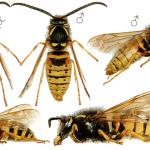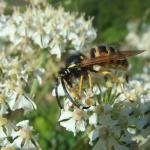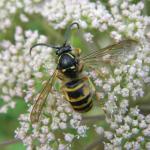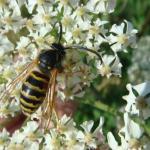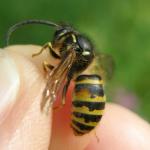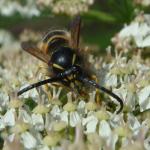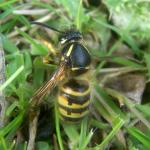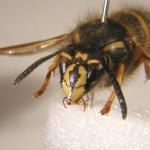Vespa albida SLADEN 1918; Vespa arctica FRIESE 1919; Vespa borealis ZETTERSTEDT 1838; Vespa britannica LEACH 1814; Vespa marginata KIRBY 1837; Dolichovespula zetterstedti BLÜTHGEN 1937
This is one of the three British ‘long-cheeked’ social wasps. Identification keys and details of biology are given in Archer (1996), Else (1994), Edwards (1980) and Spradbery (1973).
Widely distributed throughout Britain and Ireland including Orkney and Shetland (Fair Isle).
Overseas, occurs across most of northern Europe and Asia where it may be found as far north as 70°N. However, it is rare in southern Europe, where it tends to be an alpine species (in the Pyrenees, for example).
The species is not regarded as being threatened, although in common with other social wasps, it appears to have declined markedly in the late 1990s and early 2000s.
Can be found in most areas, but tends to prefer nesting adjacent to heathland and moorland in Britain (pers. obs.).
Spring queens are on the wing from mid-April to early June; workers from July to mid-October, and the newly emerged sexuals from September to October (Edwards 1980).
As with all social wasps, queens which have overwintered build nests in the spring. This species hangs its nests from the branches of low bushes, often quite close to the ground. The queen tends her brood until the first new adults emerge in June; these are the ‘workers’ who then enlarge the nest and forage for food. At the end of the season, in August, new males and females (queens) are produced. Mating takes place outside the nest, and the fertilised queens then spend some time feeding on nectar from the umbels of hogweed and other Apiaceae, before seeking suitable over-wintering sites. The males spend most of their time feeding on the same umbels, and on bramble and other late fruits. Nests are abandoned and soon break up and rot away. Only the new queens hibernate over the winter, ready to start new colonies in the following spring.
Spring queens visit the early flowers of cotoneaster and berberis for their nectar. Workers may visit figwort which has shallow flowers enabling the wasps to reach the nectaries. There are no records of other flowers being visited by this species, except for the Apiaceae mentioned above.
There are no records of parasites of British D. norwegica, but on the Continent, Chrysis austriaca is listed by Guiglia (1972). In addition, there is one social parasite, Dolichovespula adulterina, whose queens take over established nests of D. norwegica in much the same way as Vespula austriaca takes over nests of Vespula rufa in Britain (see Edwards (1998) p. 64).
2002


